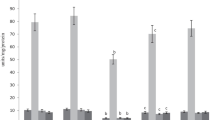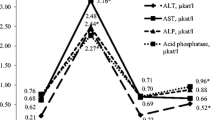Abstract
Treatment of male rats with carbon tetrachloride (CCl4, 2 × weekly 0.2 ml/kg p.o.) and a 5% alcohol solution, instead of drinking water, for 4 weeks led to marked increases in serum enzyme activities (GOT, GPT, SDH), hepatic triglyceride and hydroxyproline content. Diethyl dithiocarbamate (dithiocarb, 200 mg/kg p.o.) simultaneously applied with CCl4 totally suppressed the elevation in serum enzyme activities and hepatic hydroxyproline concentration, and partially suppressed that of the triglyceride content. (+)-Catechin (50–300 mg/kg p.o.). simultaneously applied with CCl4 had no influence on the enhanced serum enzymes, but depressed the augmented content of both hepatic triglyceride and hydroxyproline in a dose-dependent way. The most effective dose with respect to the reduction of the hydroxyproline concentration was 100 mg/kg (+)-catechin; the highest dose (300 mg/kg), however, enhanced the CCl4-alcohol-induced hydroxyproline augmentation.
Similar content being viewed by others
References
C.S. Lieber andL.M. DeCarli,An experimental model of alcohol feeding and liver injury in the baboon, J. Med. Primatol.3, 153–163 (1974).
O. Strubelt,Interactions between ethanol and other hepatotoxic agents, Biochem. Pharmac.29, 1445–1449 (1980).
S.D. Kutob andG.L. Plaa,The effect of acute ethanol intoxication on chloroform-induced liver damage, J. Pharmac. exp. Ther.135, 245–251 (1962).
C.D. Klaassen andG.L. Plaa,Relative effects of various chlorinated hydrocarbons on liver and kidney function in mice, Toxic. appl. Pharmac.9, 139–151 (1966).
H.H. Cornish andJ. Adefuin,Ethanol potentiation of halogenated aliphatic solvent toxicity, Am. ind. Hyg. Ass. Q.27, 57–61 (1966).
H.M. Maling, B. Stripp, I.G. Sipes, B. Highman, W. Saul andM.A. Williams,Enhanced hepatotoxicity of carbon tetrachloride, thioacetamide and dimethylnitrosamine by pretreatment of rats with ethanol and some comparisons with potentiation by isopropranol, Toxic. appl. Pharmac.33, 291–308 (1975).
O. Strubelt, F. Obermeier andC.-P. Siegers,The influence of ethanol pretreatment on the activity of nine hepatotoxic agents, Acta pharmac. tox.43, 211–218 (1978).
T. Glinsukon, S. Taycharpipranat andC. Toskulkao,Aflatoxin B 1 hepatotoxicity in rats pretreated with ethanol, Experientia34, 869–870 (1978).
O. Strubelt, F. Obermeier, C.-P. Siegers andM. Völpel,Increased carbon tetrachloride hepatotoxicity after low level ethanol consumption, Toxicology10, 261–270 (1978).
D.J. Prockop andS. Udenfriend,A specific method for the analysis of hydroxyproline in tissues and urine, Analyt. Biochem.1, 228–239 (1960).
C.-P. Siegers, O. Strubelt andM. Völpel,The antihepatotoxic activity of dithiocarb as compared with six other thio compounds in mice, Arch. Tox.41, 79–88 (1978).
C.P. Siegers, M. Younes andG. Schmitt,Effects of dithiocarb and (+)-cyanidanol-3 on the hepatotoxity and metabolism of vinylidene chloride in rats. Toxicology15, 55–65 (1979).
M. Younes andC.-P. Siegers,Inhibition of the hepatotoxicity of paracetamol and its irreversible binding to rat liver microsomal protein, Arch. Tox.45, 61–65 (1980).
M. Younes andC.-P. Siegers,Lipid peroxidation as a consequence of glutathione depletion in rat and mouse liver, Res. Commun. Chem. Pathol. Pharmacol.27, 119–128 (1980).
M. Younes andC.-P. Siegers,Mechanistic aspects of enhanced lipid peroxidation following glutathione depletion in vivo, Chem. biol. Interact.34, 257–266 (1981).
G. Cetta andA.A. Castellani,Cross linking of collagen in lathyrism: Influence of a flavonoid, Ital. J. Biochem.22, 148–152 (1973).
N. Blumenkrantz andG. Asboe-Hansen,Effect of (+)-catechin on collagen biosynthesis, IRCS Med. Sci. Biochemistry: Connective Tissue, Skin and Bone3, 573 (1975).
N. Blumenkrantz andG. Asboe-Hansen,Effects of some connective tissue active drugs on protocollagen proline hydroxylase activity, Scand. J. Rheumatology7, 123–127 (1978).
N. Blumenkrantz andG. Asboe-Hansen,Effect of (+)-catechin on connective tissue, Scand. J. Rheumatology7, 55–60 (1978).
M. Lonati-Galligani, L. Galligani andG.C. Fuller,Effect of (+)-catechin on purified prolyl hydroxylase and on collagen synthesis in skin fibroblasts in culture, Biochem. Pharmac.28, 2573–2578 (1979).
Author information
Authors and Affiliations
Rights and permissions
About this article
Cite this article
Siegers, CP., Völpel, M., Scheel, G. et al. Effects of dithiocarb and (+)-catechin against carbon tetrachloride-alcohol-induced liver fibrosis. Agents and Actions 12, 743–748 (1982). https://doi.org/10.1007/BF01965096
Received:
Issue Date:
DOI: https://doi.org/10.1007/BF01965096




